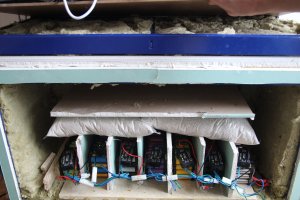Hey guys,
as I mentioned in another Thread before, I did a test of my diy casing for the lithium packs.
I build a small version and ignited6 and 12 Lithium Batteries inside the small casing.
It was a serious test, but I'd be lying if I said we didn't have fun.
I hope you don't think I'm crazy now. But the test actually calmed me down a lot because I trust the case more.
Here is the result,I found it very promising:
Here is the big version of my box, the packs above the the lithium packs tiny hollow glas balls escpecially madefor metal fire. They should fall down in case of heat and withdrawthe termal energy for melting:

as I mentioned in another Thread before, I did a test of my diy casing for the lithium packs.
I build a small version and ignited6 and 12 Lithium Batteries inside the small casing.
It was a serious test, but I'd be lying if I said we didn't have fun.
I hope you don't think I'm crazy now. But the test actually calmed me down a lot because I trust the case more.
Here is the result,I found it very promising:
Here is the big version of my box, the packs above the the lithium packs tiny hollow glas balls escpecially madefor metal fire. They should fall down in case of heat and withdrawthe termal energy for melting:



